Measuring patient satisfaction is no longer a luxury—it's a necessity. Healthcare enterprises striving for excellence must recognize that patient satisfaction directly correlates with the quality of care and organizational success.
According to a recent study by Accenture, U.S. hospitals that deliver superior patient experiences achieve net margins that are 50% higher than those of hospitals providing average experiences. Despite the clear benefits, some healthcare providers still underestimate the value of measuring patient satisfaction, viewing it as an intangible metric rather than a concrete measure of success. This oversight can lead to significant repercussions, including patient churn, diminished reputation, and financial loss.
Conversely, measuring and acting on patient satisfaction can lead to transformative improvements. For instance, the Mayo Clinic implemented a comprehensive patient feedback system and saw a notable increase in patient satisfaction scores. This not only enhanced patient loyalty but also attracted new patients, boosting overall revenue.
Understanding and prioritizing patient satisfaction enables healthcare providers to identify areas for improvement, tailor services to patient needs, and foster a culture of continuous enhancement. It is time for industry leaders to embrace patient satisfaction as a vital component of healthcare delivery, ensuring a superior experience that benefits both patients and providers.
Understanding and prioritizing patient satisfaction enables healthcare providers to identify areas for improvement, tailor services to patient needs, and foster a culture of continuous enhancement. In this article, we will delve into the methods of measuring patient satisfaction, the reasons why it is crucial to measure it, and the various touchpoints where patient satisfaction surveys can be leveraged to enhance and improve the patient experience. Let's get started!
TL;DR
-
Measuring patient satisfaction is crucial to knowing how your patients perceive your healthcare services and how satisfied they are with the overall treatment and medical facilities provided at your healthcare facility.
-
You can measure patient satisfaction by using patient satisfaction surveys, and sharing them at various touchpoints of the patient journey through multiple channels - email surveys, SMS surveys, kiosk surveys, and website surveys.
-
Placing kiosks in important areas of your hospital or clinic can fetch you instant offline feedback. Also, keep a check on online reviews and ratings, use satisfaction metrics like NPS, CES, and CSAT, and analyze your feedback data to measure patient satisfaction.
-
Measuring patient satisfaction is important for various reasons - to provide quality care to patients, to measure healthcare staff performance, to increase patient retention, and to foster quality improvement of the overall patient care.
-
You should measure patient satisfaction by sharing patient surveys at crucial touchpoints - after appointment scheduling, post-admission, post-discharge, post-consultation, cafeteria, and pharmacy.
-
Always use a good patient feedback software like Zonka Feedback that not only helps you measure patient satisfaction but also enables you to take instant actions to improve it.
Measure Patient Feedback and Satisfaction👩⚕️
Create your healthcare surveys and questionnaires and gauge feedback from patients in real-time.

Why Should Healthcare Organizations Measure Patient Satisfaction?
Understanding patient needs, issues and experiences is crucial for healthcare providers and measuring patient satisfaction enables you to do this. It provides invaluable insights that can drive improvements, foster patient loyalty, and enhance the overall quality of care. Here are key reasons why as a healthcare organization you should prioritize measuring patient satisfaction:
1. To Provide Top Quality Healthcare Services
Measuring patient satisfaction allows healthcare providers to gather direct feedback on the quality of care delivered. This feedback helps in identifying strengths and areas needing improvement, ensuring that the services provided meet patient expectations and standards.
2. To Track Staff Performance
Measuring patient satisfaction can reveal valuable information about staff performance. Feedback related to communication, professionalism, and empathy can be tracked and addressed by measuring patient satisfaction with different aspects. Press Ganey’s research indicates that hospitals with higher staff satisfaction scores often have better patient satisfaction outcomes, highlighting the importance of monitoring and improving staff performance.
3. To Identify Points of Patient Frustration and Reduce Them
By measuring patient satisfaction, you can pinpoint specific areas of frustration for patients. Whether it’s long wait times, complicated billing processes, or poor communication, understanding these pain points allows for targeted improvements. According to a study by the Beryl Institute, organizations that actively address patient feedback see a 21% reduction in patient complaints.
3. To Ensure a Frictionless Patient Journey
Measuring patient satisfaction at different touchpoints for the patient journey can highlight obstacles that patients face during their healthcare journey, from scheduling appointments to follow-up care. This helps you know the challenges that your patients face and guides action to remove or reduce those challenges to ensure a frictionless journey for your patients.
4. To Improve Patient Retention Rate
Measuring patient satisfaction guides action to create better experiences and enhance patient satisfaction. Satisfied patients are more likely to return for future care and recommend the facility to others. Research conducted by Press Ganey found that hospitals with high patient satisfaction scores see a 15% increase in patient retention rates. By addressing the issues highlighted in patient feedback, healthcare organizations can foster loyalty and ensure patients feel valued and cared for, ultimately improving retention rates.
5. To Attract New Patients
Positive word-of-mouth from satisfied patients is a powerful tool for attracting new patients. High patient satisfaction scores enhance a healthcare organization’s reputation both online and offline. According to a report by NRC Health, 83% of patients trust online reviews as much as personal recommendations, emphasizing the importance of maintaining high satisfaction scores to attract new patients.
6. To Minimize Legal Risks
Measuring patient satisfaction can help identify potential areas of risk and dissatisfaction before they escalate into legal issues. A study published in the American Journal of Medicine found that improved communication and patient satisfaction were associated with a 21% decrease in malpractice claims. Addressing patient concerns and improving the overall patient experience demonstrates a commitment to patient care, which can mitigate legal risks and enhance the facility's reputation.
How to Start Measuring Patient Satisfaction?
While starting with measuring patient satisfaction, healthcare enterprises must adopt a strategic and comprehensive approach. This process goes beyond basic feedback collection and involves leveraging advanced tools, detailed analytics, and integration with existing systems to gain deep insights into the patient experience. Here are the steps to effectively measure patient satisfaction:
1. Choose an Effective Patient Feedback Software
Selecting a robust patient feedback software is crucial for gathering comprehensive and actionable insights. When choosing a software, ensure it has the following features:
-
Multi-Channel Distribution: The software should support various distribution methods such as online surveys, email, SMS, in-app, and kiosk-based surveys to reach patients wherever they are.
-
Skip Logic and Question Branching: These features allow surveys to be dynamic and conversational by tailoring follow-up questions based on previous responses, ensuring a more personalized and relevant survey experience.
-
Metric Surveys: Incorporate standardized metrics like Patient Satisfaction Score (PSS), Net Promoter Score (NPS), and Patient Effort Score (PES) to measure different aspects of patient satisfaction effectively.
-
AI-Powered Analysis: Features like sentiment analysis and text analysis can provide deeper insights into patient feedback by identifying underlying emotions and themes in open-ended responses.
Zonka Feedback is an example of such software that encompasses all these features, making it a comprehensive tool for measuring patient satisfaction.
2. Design Comprehensive and Effective Surveys
- Choose a suitable template - Choose a customizable survey template that aligns with your objectives. The template should fit your specific needs, like an inpatient survey template to measure the satisfaction of your inpatients at the hospital, an outpatient survey template for measuring the satisfaction of your outpatients at the hospital or clinic, a resident satisfaction template to measure the satisfaction of your aged care residents, and pharmacy survey template to measure satisfaction with your pharmacy services.
- Use the Right Metrics - Depending on your survey objectives, choose appropriate metrics like:
- Patient Satisfaction Score (CSAT): To measure the overall satisfaction with treatment, care, and the healthcare experience.
- Net Promoter Score (NPS): NPS in healthcare can be used to gauge patient loyalty and likelihood to recommend your services to others.
- Patient Effort Score (PES): To assess how easy it was for patients or their family members to navigate various touchpoints of their healthcare journey like appointment booking, medical tests, discharge process, bill payment and getting medical insurance benefits.
- Make your surveys conversational - Make your surveys dynamic and conversational with the respondents. This means the next question should dynamically appear based on previous answers, making the survey more engaging and relevant. Utilizing features like skip logic and question branching will serve the purpose.
3. Use Multiple Distribution Channels
To get a holistic view of patient satisfaction, it's crucial to distribute surveys through various channels, ensuring you capture feedback at all touchpoints in the patient journey. Implement a strategy that includes:
- Website Surveys: Deploy surveys on your website where patients explore information or book appointments. This can capture immediate feedback on the ease of use and overall experience.
- In-App Surveys: If your healthcare facility has an active mobile app, integrate surveys within the app to gather feedback from patients who book appointments or use other services through the app.
- Kiosk Surveys: Place kiosks at strategic locations like reception areas, pharmacies, and waiting rooms to collect real-time feedback from patients during their visit.
- Email or SMS Surveys: Send follow-up surveys via email or SMS after patient discharge to gather comprehensive feedback on their entire experience, from treatment to post-care services.
4. Analyse the Survey Responses
Once the feedback is collected, the next step is to analyze the data to extract actionable insights.
-
Use Real-Time Reporting and Dashboards: Use real-time reporting tools to monitor survey responses as they come in, allowing for immediate action on urgent issues.
- Use Sentiment and Text Analysis: Utilize AI-powered tools like Sentiment Analysis and Text Analysis to analyze open-ended responses, identifying common themes, sentiments, and areas of concern.
-
Use Segmentation and Filtering: Analyze responses based on demographics, visit type, department, or other relevant categories to identify specific areas of strength and those needing improvement.
By thoroughly analyzing the survey responses, you can gain a comprehensive understanding of patient satisfaction levels and identify actionable areas for improvement.
By following these steps and leveraging advanced feedback software like Zonka Feedback, you can effectively measure patient satisfaction, driving continuous improvement and enhancing the overall patient experience.
Ways to Measure Patient Satisfaction
Measuring patient satisfaction involves capturing feedback from patients through various methods, each offering unique insights into the patient experience. Here are some effective ways to measure patient satisfaction.
1. Patient Satisfaction Surveys
Patient satisfaction surveys are one of the most direct and comprehensive methods for gathering feedback and measuring satisfaction of your patients.
- Designing effective surveys with standardized questions is crucial. These surveys should include both quantitative (e.g., Likert scale) and qualitative (e.g., open-ended) questions to capture a range of patient insights.
- Surveys can be distributed through various methods, such as email, SMS, or in-app surveys. Ensuring that surveys are mobile-friendly increases the likelihood of patient participation.
- The frequency and timing of surveys are also important. Consider sending surveys post-appointment, post-discharge, or on an annual basis to gather timely feedback.
- Personalizing surveys by tailoring questions based on patient demographics and visit reasons can lead to more relevant and insightful responses.
2. Focus Groups
Focus groups involve gathering a small, diverse group of patients to discuss their experiences and provide detailed feedback on specific aspects of their care. This qualitative approach allows for deeper insights into patient perceptions, attitudes, and suggestions for improvement. Focus groups can uncover issues that might not be apparent through surveys alone and provide a platform for patients to express their opinions in a more personal and interactive setting.
- Conducting focus groups to gather in-depth insights requires careful participant selection to ensure diverse perspectives.
- Structured discussions can uncover detailed perceptions, including pain points, expectations, and suggestions for improvement.
- Holding regular focus group sessions helps keep up-to-date with patient needs and ensures continuous improvement based on patient feedback.
3. Patient Portals
Patient portals offer a convenient and accessible way for patients to provide feedback and engage with their healthcare providers. These online platforms can include features such as satisfaction surveys, feedback forms, and direct communication channels with healthcare staff. By integrating feedback mechanisms into patient portals, you can encourage real-time feedback and promptly address any concerns or issues raised by patients.
4. Social Media and Online Reviews
Social media platforms and online review sites are valuable sources of patient feedback. Patients often share their experiences on platforms like Facebook, Twitter, Yelp, and Google Reviews. Monitoring and analyzing this feedback can provide you with insights into patient sentiment and areas for improvement.
- Engage with patients by responding promptly to both positive and negative reviews. It demonstrates a commitment to patient satisfaction. Engage with patients by responding to reviews, showing commitment to satisfaction. Drug comparing can further help assess treatment effectiveness based on feedback. Regular audits of reviews reveal trends, providing actionable insights for enhancing patient experiences.
- Use feedback to address concerns and improve services which is vital for ongoing enhancement.
- Conduct regular audits of online reviews. It helps to identify trends and common issues, providing actionable insights for improving patient experiences.
5. Analyzing Referrals
Referrals can serve as an indirect measure of patient satisfaction. Patients who are satisfied with their care are more likely to refer friends and family to the same healthcare provider. By tracking and analyzing referral patterns, you can gauge patient loyalty and satisfaction levels. High referral rates often indicate positive patient experiences and trust in the provider.
6. Patient Experience Mapping
Patient experience mapping involves creating a detailed visualization of the patient's journey through the healthcare system. This method helps identify key touchpoints and interactions that impact patient satisfaction.
By mapping the entire patient journey, healthcare organizations can pinpoint areas where improvements are needed and implement targeted strategies to enhance the overall experience.
7. Benchmarking Patient Satisfaction Scores
Benchmarking involves comparing patient satisfaction scores with industry standards or similar healthcare facilities. This process helps identify strengths and areas for improvement by providing a context for the organization's performance. Benchmarking can motivate healthcare providers to strive for higher satisfaction levels and adopt best practices from top-performing institutions.
By employing a combination of these methods, you can gain a comprehensive understanding of patient satisfaction and continuously improve the quality of care they provide. Regularly measuring and analyzing patient feedback is essential for enhancing the patient experience and fostering a patient-centered approach in healthcare.
Key Metrics to Measure Patient Satisfaction
Using specific metrics allows healthcare providers to better understand patient experience and satisfaction. Metrics help you to quantify satisfaction levels, identify strengths and weaknesses, and make data-driven decisions. Here are some key metrics to measure patient satisfaction effectively.
1. Net Promoter Score
Net Promoter Score (NPS) is a widely used metric to gauge patient loyalty and the likelihood of recommending the healthcare provider to others. Patients are asked to rate their likelihood of recommending the provider on a scale from 0 to 10.
Based on their responses, patients are categorized into three groups:
- Promoters (9-10): Highly satisfied patients likely to recommend the provider.
- Passives (7-8): Satisfied but unenthusiastic patients who are vulnerable to competitive offerings.
- Detractors (0-6): Unsatisfied patients who may discourage others from using the provider.
The NPS is calculated by subtracting the percentage of Detractors from the percentage of Promoters. A higher NPS indicates better patient satisfaction and loyalty.
2. Patient Satisfaction Score
The Patient Satisfaction Score (CSAT or PSS) provides a direct measure of a patient's overall satisfaction with their healthcare experience. This score is typically derived from surveys where patients rate various aspects of their experience, such as:
- Quality of care
- Communication with healthcare providers
- Ease of scheduling appointments
- Wait times
- Facility cleanliness
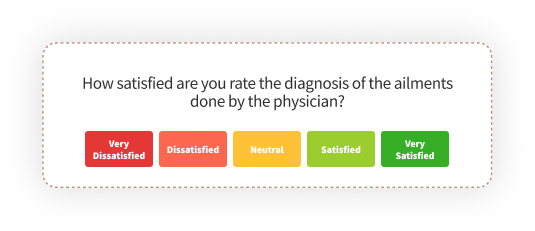 Patient satisfaction score offers a comprehensive view of patient satisfaction, highlighting both strengths and areas needing improvement.
Patient satisfaction score offers a comprehensive view of patient satisfaction, highlighting both strengths and areas needing improvement.
3. Patient Effort Score
The Patient Effort Score (PES) measures the ease with which patients can navigate the healthcare system and receive the care they need. This metric focuses on the patient's perspective of the effort required to:
- Schedule appointments
- Access healthcare services
- Obtain information about their care
- Communicate with healthcare providers
Patients are typically asked to rate statements like, "The healthcare provider made it easy for me to get the care I needed," on a scale from 1 (Strongly Disagree) to 5 (Strongly Agree). A lower effort score indicates a smoother, more satisfactory patient experience.
4. CG-CAHPS
The Clinician and Group Consumer Assessment of Healthcare Providers and Systems (CG-CAHPS) is a standardized survey tool used to measure patients' experiences with healthcare providers and staff in ambulatory settings. The CG-CAHPS survey covers several key aspects of patient care, including:
- Access to care
- Communication with healthcare providers
- Care coordination
- Courteousness of office staff
The CG-CAHPS provides valuable benchmark data, allowing healthcare organizations to compare their performance against national standards and identify areas for improvement.
By utilizing these key metrics, you can obtain a comprehensive understanding of patient satisfaction, identify areas for improvement, and implement strategies to enhance the overall patient experience. Regularly monitoring these metrics ensures that your organization remains responsive to patient needs and committed to providing high-quality care.
Some Advanced Methods of Measuring Patient Satisfaction
To stay ahead in understanding and improving patient experiences, healthcare organizations are increasingly adopting advanced methods for measuring patient satisfaction. These innovative techniques provide deeper insights and more precise data, enabling targeted improvements. Here are some advanced methods for measuring patient satisfaction.
1. Sentiment Analysis
Sentiment analysis involves using natural language processing (NLP) and machine learning algorithms to analyze patient feedback from various sources, such as surveys, social media, and online reviews. This technique identifies and quantifies the sentiments expressed by patients, categorizing them as positive, negative, or neutral. By understanding the emotional tone of patient feedback, healthcare providers can:
- Detect underlying issues affecting patient satisfaction.
- Identify areas that are consistently praised or criticized.
- Make data-driven decisions to enhance patient experience.
2. Location-Based Analytics
Location-based analytics leverage geographic information system (GIS) technology to analyze patient satisfaction data based on location. This method can uncover patterns and trends related to geographic factors, such as:
- Variations in patient satisfaction across different clinics or regions.
- Impact of location-specific factors on patient experience (e.g., accessibility, local demographics).
- Identifying areas where targeted improvements are needed.
By integrating location-based analytics with patient feedback, you can tailor your strategies to address specific regional needs and enhance overall satisfaction.
3. Predictive Analysis
Predictive analysis uses advanced statistical techniques and machine learning algorithms to forecast future patient satisfaction trends based on historical data. This method can help healthcare providers:
- Identify potential areas of concern before they become significant issues.
- Allocate resources more effectively to areas needing improvement.
- Develop proactive strategies to maintain or improve patient satisfaction.
Predictive analysis enables healthcare organizations to stay ahead of patient needs and continuously enhance the quality of care.
4. AI-driven Chatbots for feedback collection
AI-driven chatbots are increasingly being used to collect real-time patient feedback. These chatbots can engage with patients through various digital channels, such as websites, mobile apps, and social media platforms. Benefits of using AI-driven chatbots include:
- Immediate and continuous feedback collection.
- High response rates due to the convenience and accessibility of chatbots.
- Ability to handle large volumes of feedback efficiently.
By analyzing the feedback collected through chatbots, you can gain valuable insights into patient experiences and make timely improvements.
5. Setting up Voice of Patient Program
A Voice of Patient (VoP) program is a structured approach to continuously capture, analyze, and act on patient feedback. Setting up a VoP program involves:
- Collecting feedback from multiple sources, such as surveys, interviews, focus groups, and social media.
- Using advanced analytics to identify trends, patterns, and areas for improvement.
- Implementing changes based on patient insights and monitoring the impact.
A VoP program ensures that patient feedback is integrated into the organization’s decision-making processes, fostering a culture of patient-centered care and continuous improvement.
By adopting these advanced methods, healthcare organizations can gain a deeper understanding of patient satisfaction, uncover actionable insights, and enhance the overall patient experience. Embracing innovative techniques ensures that the organization remains responsive to patient needs and committed to providing high-quality care.
Move Beyong Measurement: Take Action
Measuring patient satisfaction is only the first step toward improving the patient experience. Once you have gathered and analyzed patient feedback, the next critical phase is to take actionable steps based on these insights. Here’s how you can effectively move beyond measurement and implement changes that drive improvements.
1. Identify Key Areas for Improvement
Use the data collected from patient satisfaction surveys, focus groups, and other feedback methods to pinpoint specific areas needing attention. Look for recurring themes or issues that significantly impact patient satisfaction. Prioritize these areas based on their frequency and severity to ensure that efforts are directed where they will have the most substantial impact.
2. Develop Action Plans
For each identified area of improvement, create a detailed action plan that outlines the steps necessary to address the issues. This plan should include:
-
Specific Objectives: Define clear goals for what you aim to achieve.
-
Action Steps: Outline the tasks and activities needed to reach these goals.
-
Responsible Parties: Assign roles and responsibilities to team members.
-
Timelines: Establish deadlines and milestones to track progress.
-
Resources: Identify the resources needed, such as training, technology, or additional staff.
3. Engage and Train Staff
Ensure that all healthcare providers and staff members are aware of the feedback and the action plans. Training programs should be developed to address identified deficiencies, such as improving communication skills, enhancing patient interaction, and streamlining processes. Engaging staff in the feedback loop fosters a culture of continuous improvement and accountability.
4. Implement Changes
Execute the action plans systematically. This may involve:
- Process Improvements: Streamlining administrative procedures, reducing wait times, and enhancing care coordination.
- Technology Integration: Implementing new technologies like electronic health records (EHRs), patient portals, or telehealth services to improve patient access and experience.
- Facility Enhancements: Upgrading facilities, improving cleanliness, and creating a more comfortable environment for patients.
5. Monitor Progress and Adjust
Continuously monitor the impact of the changes implemented. Use follow-up surveys, patient feedback, and performance metrics to assess whether the changes are yielding the desired outcomes. Be prepared to make adjustments as needed. Continuous monitoring ensures that improvements are sustained and that new issues are promptly addressed.
6. Communicate with Patients and Close the Feedback Loop
Keep patients informed about the changes being made in response to their feedback. Transparency builds trust and shows patients that their opinions are valued. Use newsletters, emails, or updates on your website to communicate these improvements. Highlighting positive changes can also encourage more patients to provide feedback in the future.
7. Foster a Culture of Continuous Improvement
Encourage a culture where feedback is regularly sought and acted upon. Make patient satisfaction a key performance indicator and integrate it into regular staff meetings and training sessions. Recognize and celebrate the successes and improvements achieved as a result of acting on patient feedback.
Acknowledge the efforts of staff and share positive outcomes with the entire organization. It reinforces a culture of continuous improvement and motivates staff to maintain high standards of care.
Using Zonka Feedback to Measure Patient Satisfaction
Zonka Feedback is a comprehensive platform designed to help healthcare organizations measure and improve patient satisfaction. Here are the steps to create and share patient satisfaction surveys, collect feedback, and analyze the data using Zonka Feedback.
1. Sign Up and Set Up Your Account
Begin by signing up for a Zonka Feedback account. Once registered, set up your account by adding your healthcare facility's details, branding elements, and any specific customization needed for your surveys.
2. Create a New Survey
- Choose a Template: Zonka Feedback offers a variety of pre-designed ready-to-use templates for patient satisfaction surveys. Select a template that best fits your needs or create a custom survey from scratch.

- Design the Survey: Customize the survey by adding your logo, colors, and other branding elements. Ensure the survey includes both quantitative questions (e.g., Likert scale) and qualitative questions (e.g., open-ended) to gather comprehensive feedback. You can add, remove, or modify the healthcare assessment questions as per your survey needs.

- Add Metrics: Incorporate standardized metrics such as Net Promoter Score (NPS), Patient Satisfaction Score (CSAT), and Patient Effort Score (CES) to measure specific aspects of patient satisfaction.
3. Customize the Survey Logic
- Skip Logic and Question Branching: Use skip logic and question branching to make the survey conversational and relevant. This ensures that patients only see questions that are pertinent to their experiences.
- Survey Variables: Utilize survey variables to personalize the survey experience. Variables can dynamically insert patient-specific information such as the patient's name, the department they visited, or the date of their appointment, making the survey feel more personalized and relevant to each respondent.
- Personalization: Tailor questions based on patient demographics, visit reasons, or previous responses to get more detailed and specific feedback.
4. Set Up Distribution Channels
Zonka Feedback supports multiple distribution channels, ensuring broad reach and convenience for patients. Set up the survey to be distributed via:
- Email: Send surveys to patients' email addresses post-appointment or discharge.
- SMS: Use SMS surveys for quick feedback collection, especially for outpatient services.
- In-App Surveys: Integrate surveys within your healthcare app for patients who book appointments or access services through the app.
- Kiosk Surveys: Deploy touchscreen kiosks in waiting areas, reception, or pharmacies to collect on-site feedback.
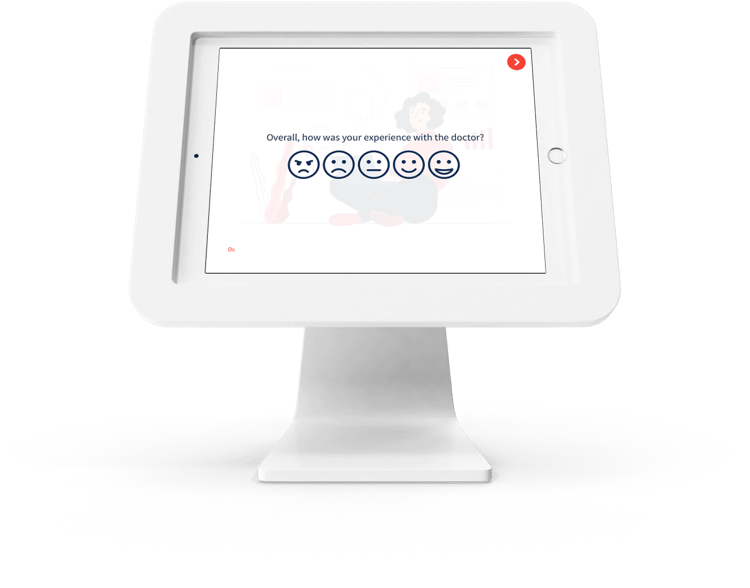
- Website Surveys: Embed surveys on your website where patients can provide feedback while exploring services or booking appointments.
5. Schedule and Automate Surveys
- Timing: Schedule surveys to be sent at optimal times such as immediately after appointment booking, post-appointment, post-discharge, or at regular intervals (e.g., annually) to capture timely feedback.

- Automation: Automate the survey distribution process to ensure consistency and save time. Zonka Feedback’s automation features allow for setting up triggers based on patient interactions.
Collecting and Analyzing Feedback
6. Collect Feedback
- Real-Time Collection: As patients respond to the surveys, Zonka Feedback collects the data in real-time, allowing you to monitor responses as they come in.
- Segmentation: Segment the feedback based on demographics, visit type, department, or other relevant categories to gain deeper insights.
7. Analyze Feedback
- Dashboard: Use Zonka Feedback’s intuitive dashboard to view all survey responses. The dashboard provides a comprehensive overview with visualizations such as charts and graphs.
- Sentiment Analysis: Leverage AI-powered sentiment analysis to understand the emotions behind patient comments. This helps identify positive, negative, or neutral sentiments.
- Detailed reporting and analysis: Generate detailed reports to analyze specific aspects of patient satisfaction. Reports can highlight trends, recurring issues, and areas of excellence.
- Benchmarking: Compare your patient satisfaction scores against industry benchmarks to understand your performance relative to other healthcare providers.

By following these steps and leveraging Zonka Feedback’s robust features, you can effectively measure patient satisfaction, gain actionable insights, and continuously improve the patient experience.
Touchpoints where you can measure Patient Satisfaction
Measuring patient satisfaction at different touchpoints helps you identify the pain points of your patients and make the right decision and action for improving your health care and medical services. You can collect patient feedback at various touchpoints like:
-
Post-Appointment booking - You can use SMS surveys and website surveys to collect feedback about the appointment booking process. Ask the patients how easily they were able to book appointments through the website or call.
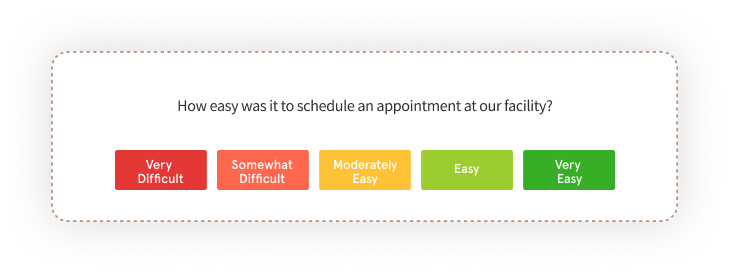
-
Waiting Time - Waiting time is a crucial part that affects patient satisfaction. Ask the patients if they had to wait for long for their appointments and how satisfied they are with the accuracy of the timings of the appointments.
-
Post Consultation - Collect feedback about your doctors and physicians post-consultation to know how satisfied your patients are with the diagnosis and the overall interaction with the doctor.
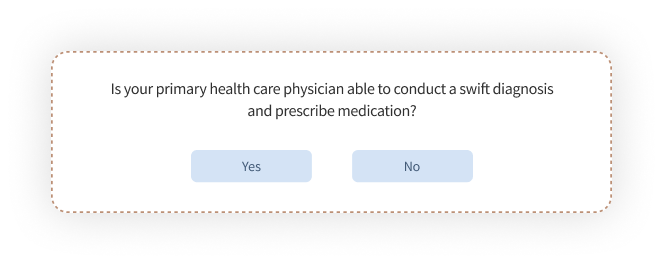
-
Post Admission - If you are running a hospital, it is essential to have a smooth admission process to provide immediate care and treatment to the patients. Ask your patients how easy and smooth was for them to get admitted to your hospital and how helpful was your hospital staff during the process.
-
Post-Discharge - Like admission, discharge is also a crucial touchpoint that affects the overall inpatient experience. When your inpatients are discharged from the hospital, you can send patients satisfaction surveys through emails or SMS asking about their satisfaction with the process as well as their overall experience in the hospital.
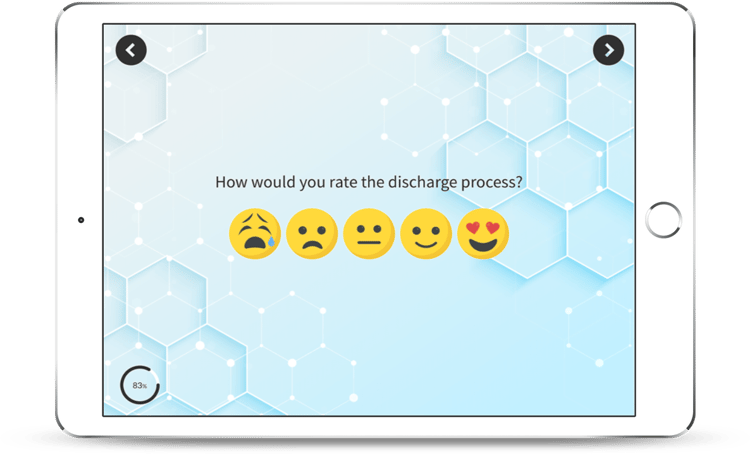
-
Pharmacy - Ask your patients about their experience at the pharmacy and whether they were able to procure the medicines they needed. Collect feedback about pharmacy staff, availability of medicines, pricing, and billing process at the pharmacy.
-
Cafeteria - Deploy survey kiosks at your cafeteria to collect feedback and measure satisfaction with important aspects of your cafeteria like food, cleanliness, and overall services at the cafeteria.
Conclusion
Understanding patient preferences and their health issues is the key to creating better patient experiences. It’s invaluable for your facility to know how your patients feel about our healthcare and medical services. Communication is one of the biggest challenges in the healthcare industry. To overcome this challenge and boost engagement, patient satisfaction surveys are the best way out.
With a good patient feedback app or software, you can set up an effective patient feedback system and can easily create customized and engaging healthcare surveys to find out the pain points of your patients, where you lack, whether there’s any room for improvement, and what measures you can implement to enhance your care and services. Additionally, it ensures that your patients understand that their opinion matters to you and can help you improve your online reputation.
Zonka Feedback is one such patient feedback software that you can use for this purpose. With its features like real-time feedback alerts and notifications, it not only lets you measure patient satisfaction but also enables you to take instant action on feedback to close the feedback loop and improve patient experience before it's too late.
Schedule a demo and see how it works to boost your healthcare business.
.jpg)

.png)


.png)



